
A blunt is a cigar which is wider than a cigarillo and not quite as wide as a Corona, generally equivalent to a petit corona while short panatellas are sometimes classified as mini-blunts. These cigars typically consist of two main parts; the inner leaf, which is similar to a cigarette rolling paper, except it is made of tobacco, and a thicker outer leaf which is rolled around the inner leaf in a spiral. In most commercially available blunts, the "leaves" are not actual tobacco leaves but rather paper made from tobacco pulp.
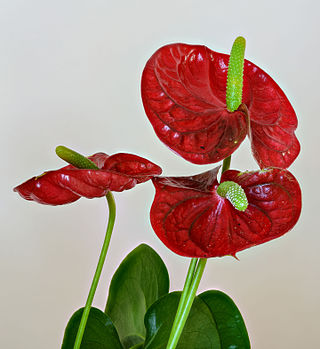
Anthurium is a genus of about 1,000 species of flowering plants, the largest genus of the arum family, Araceae. General common names include anthurium, tailflower, flamingo flower, pigtail plant, and laceleaf.
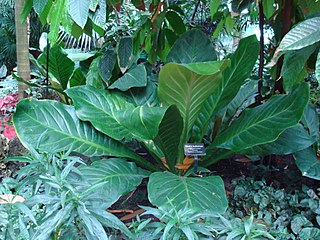
Anthurium hookeri, commonly called a bird's nest anthurium, is a species of flowering plant in the genus Anthurium. Anthurium hookeri possesses some unique features which include, short internodes, dense roots, and lanceolate cataphylls. The leaves have triangular to D-shaped petioles 2–9 cm long, are rosulate, 10–26 cm wide, 35–89 cm long. The leaves exhibit a scalariforme venation and supervolute vernation. Covering the leaves are tiny black glandular punctuates. The berries produced by the plant are white.

Anthurium andraeanum is a flowering plant species in the family Araceae that is native to Colombia and Ecuador. It is a winner of the Royal Horticultural Society's Award of Garden Merit.

Anthurium clarinervium is a species of flowering plant in the family Araceae native to Chiapas, Mexico. The Anthurium genus is known to contain approximately 1,000 species, resulting in one of the most diverse Central American tropical plant genera.

Anthurium pedatoradiatum or Anthurium Fingers is a species of plant in the genus Anthurium native to southern Mexico. A. pedatoradiatum has leaves with deep finger-like sections, and is terrestrial. Its natural habitat is from sea level up to 1,000 meters (3,300 ft) in the Mexican states of Veracruz, Tabasco, and Chiapas. It is related to other Anthurium in the section Schizoplacium such as Anthurium podophyllum, and its species name in Latin refers to the radiating growth of its palm-like leaves.
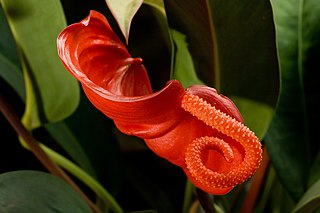
Anthurium scherzerianum, the flamingo flower or pigtail plant, is a species of Anthurium native to Costa Rica. It has gained the Royal Horticultural Society's Award of Garden Merit as an ornamental houseplant, kept at 15 °C (60 °F) or higher. It is naturally an epiphyte, growing on trees in the rainforest.

Anthurium magnificum is a plant in the genus Anthurium native to Colombia. Closely resembling other Anthurium species like Anthurium crystallinum, it has large, cordate leaves with prominent veining and is primarily terrestrial. Plants of the true species can be distinguished primarily by their quadrangular petioles.
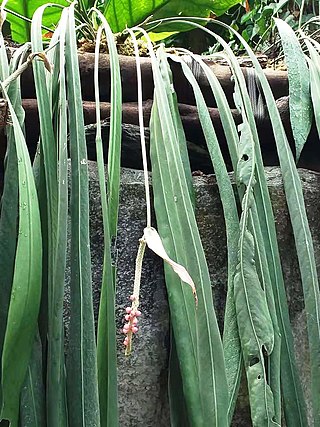
Anthurium vittariifolium is a species of flowering plant in the genus Anthurium native to the Amazon basin; southeast Colombia, Ecuador, Peru, and northern Brazil. With its long, pendulous leaves that can reach 2.4 m (8 ft), it is among those commonly known as "strap-leaved" anthuriums. It grows as an epiphyte at lower elevations of tropical moist forests, and is a member of the section Leptanthurium along with Anthurium gracile.

Anthurium regale is a species of Anthurium, a genus of flowering aroid plant in the family Araceae. It was first described by Europeans in the 1866 edition of La Belgique Horticole, where it was noted to be first collected for the houseplant trade by Gustav Wallis during his time working for Jean Jules Linden. This impressive and sought-after Anthurium species is native to Perú, where it may be found near the Huallaga River valley, to the north of Tingo María and Juanjuí, in the regions of Huánuco and San Martín, respectively. This species is found in forested areas, where it grows on trees epiphytically, ranging from sea-level environments to cloud forests, up to about 243 meters in elevation. A. regale is often found in areas where the ambient humidity is consistently high, and where temperatures remain steadily between 15 °C (59°F) and 26.6 °C (80°F).

Anthurium coriaceum is a species of plant in the genus Anthurium native to southeast Brazil. A "bird's nest" type of Anthurium of the section Pachyneurium, it grows either terrestrially or epilithically in areas of seasonal dryness. It has erect leaves that feel like leather, which is where its scientific name derives from.
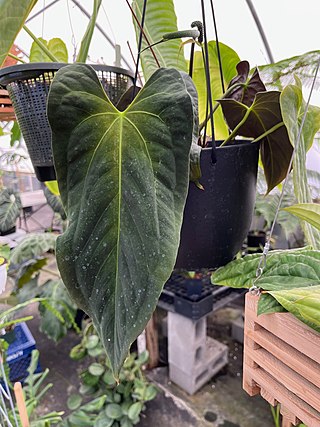
Anthurium papillilaminum is a species of plant in the genus Anthurium native to Panama. A. papillilaminum grows terrestrially and has very dark green cordate leaves on short stems. Its native range is very limited, with the species endemic to only the coasts of Colón Province and Darién Province up to 100 meters (330 ft) above sea level. A member of the section Cardiolonchium, it is closely related to other velvet-leaved Anthuriums, though it does not have silver veins on the leaves like Anthurium crystallinum.

Anthurium corrugatum is a species of plant in the genus Anthurium native to Central and South America from Panama to Ecuador. This species is noted for its cordate leaves with a network of fine veins that gives it a bullate appearance. A terrestrial grower, it is adapted to cool, humid climates. It is a member of the section Polyneurium along with Anthurium argyrostachyum and others.

Anthurium podophyllum is a species of plant in the genus Anthurium native to coastal areas of the Mexican states of Veracruz and Oaxaca. A terrestrial species, it grows in tropical forest understories in seasonally dry areas. It is named for its palmate leaves that somewhat resemble plants in the (unrelated) genus Podophyllum, and which have many subdivisions. It is related to other terrestrial Anthurium with similar leaf morphology in the section Schizoplacium, such as Anthurium pedoradiatum, and produces orange berries.

Anthurium jenmanii is a species of plant in the genus Anthurium. Growing as an epiphyte subshrub, it is native to South America from Trinidad and Tobago to Brazil. A member of the section Pachyneurium, and like related species it has a "birds nest" growth habit. It has a dark purple-black spadix and spathe, and produces red berries. In cultivation, it is commonly mistaken for Anthurium bonplandii subsp. guayanum, a related species.
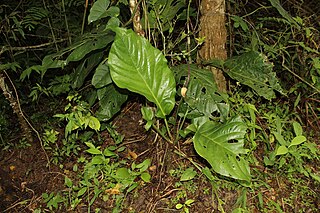
Anthurium bonplandii is a species of plant in the genus Anthurium native to South America. A member of the Anthurium sect. Pachyneurium, it grows terrestrially or occasionally epiphytic or epilithic. It is often confused with Anthurium jenmanii when young and Anthurium atropurpureum.

Anthurium dwyeri is a species of plant in the genus Anthurium native from Costa Rica to the Chocó Department of Colombia. Named in honor of the botanist Dr John D. Dwyer, it has no known close relatives but is a member of the section Porphyrochitonium. An epiphyte, it is most easily recognizable by its leathery, oblong to elliptical leaves that are 24–40 centimetres (9.4–15.7 in) long and grow on triangular stems.

Anthurium coloradense is a species of plant in the genus Anthurium native to Panama. A member of the section Polyneurium, this terrestrial shrub is most recognizable by its thin, veined leaves and its yellow-green spadix. Its foliage is very similar to other Panamanian species such as Anthurium caperatum, Anthurium santamariae and Anthurium cerrosantiagoense but may be distinguished by details such as the grooves in its stems and the pattern of veining, with the collective vein growing from the third vein in a leaf.

Anthurium wendlingeri is a species of aroid plant, in the genus Anthurium, found from Central to South America, from SE Nicaragua to NW Colombia. It grows in moist, montane tropical habitats as an epiphyte. Unique among its genus, A. wendlingeri has long, pendant and strap-like leaves, and can have a slightly velvety appearance.
Anthurium lentii is a species of flowering plant in the family Araceae, native to Colombia, Costa Rica and Panama. It grows in wet tropical habitats, and is a member of section Digitinervium.



















